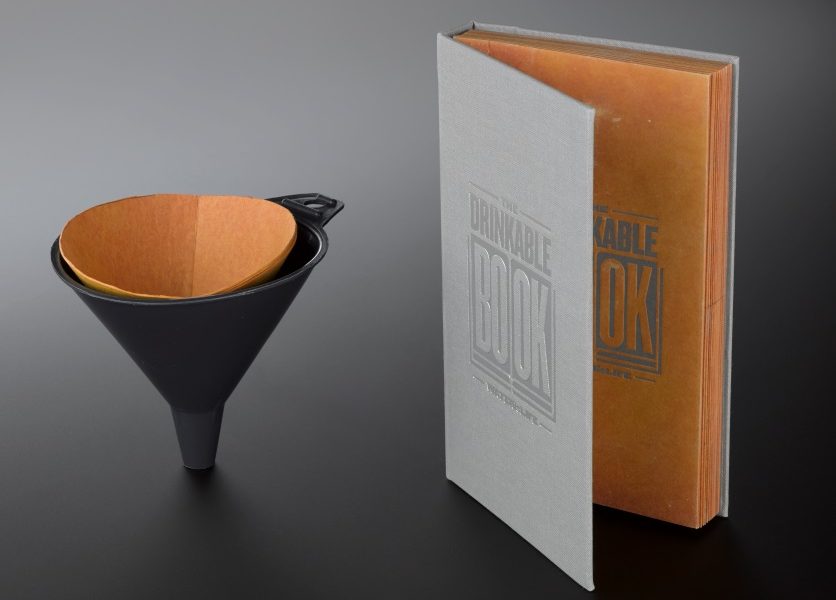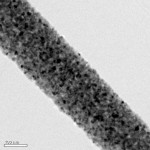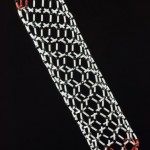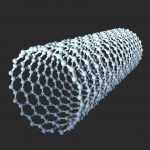Nanoscience and nanotech research covers a wide range of areas including healthcare, materials, combating climate change and nanotechnology’s interaction with people and the environment.
Our latest topical case in the Antenna gallery features the Drinkable Book, a book containing both educational information and paper water filters. Each page is printed with text about cleaning water and is embedded with silver nanoparticles, which are antibacterial.
When dirty water is passed through a page, bacteria in the water are killed by these tiny particles of silver. This got me thinking about nanoparticles and nanotechnology in general. Why are these small particles so useful? What makes them special?

Nanotechnology is…
Put simply, nanotechnology is technology on a small scale, working with atoms and molecules. Nanoparticles themselves are very small particles, the next size up on this scale.
Nanoparticles of a variety of different substances are now used in hundreds of consumer products.
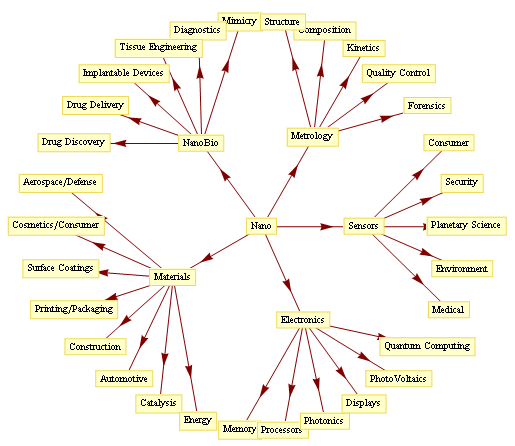
So how small are we talking?
Nanoparticles and matter at this scale are measured in nanometres – 1 nanometre is 1 billionth of a metre.
The London Centre for Nanotechnology describes nanotechnology as ‘a set of technological tools that rely on the ability to control matter precisely on length scales below 100nm’.
It’s hard to imagine how small this is when we’re talking about things you can’t even see. But a piece of paper is roughly 100,000 nanometres thick and the size of a gold atom is about a third of a nanometre.
Look for 1 nanometre and a carbon nanotube on The Scale of the Universe – you’ll find them next to DNA and atoms!
So nanotechnology involves working with things that are all very small. It crosses scientific disciplines including physics, chemistry, engineering and biology. Synthesising nanoparticles is a part of this type of research. It involves manipulating atoms and molecules to create man-made nanoparticles of particular sizes that don’t behave in the same way as larger particles of the same material.

How new are nanoparticles?
Nanoparticles were actually used by the Romans – although they didn’t know it. The Lycurgus Cup – about 1600 years old – is an ornate glass cup that normally appears green. But when light is shone through it, it appears red because of silver and gold nanoparticles in the glass. Researchers think the people who made it ground down the silver and gold and mixed them with the glass when it was a hot liquid.
Nanoparticles are created naturally and come off larger objects all the time. What’s different about nanotechnology is that these particles are being deliberately made for specific purposes; they can be engineered in specific sizes and shapes, and if you make a lot of them they can be used for a variety of purposes including in clothing and as coatings and coverings.
Why are they in my socks?
When it comes to nanoparticles, their size is what gives them their special properties. For example, silver nanoparticles have longer-lasting antibacterial properties than bigger particles of silver. That’s why they can be used in socks, to kill bacteria and prevent bad smells.
Nanoparticles can be made of many different substances. Titanium dioxide can be a more effective ingredient of sunscreen if it’s present as nanoparticles rather than larger particles. Carbon nanotubes are useful because they are super strong.
The bigger picture
New nanotechnology is being developed all the time. Metals can be infused with nanoparticles to make them super strong and lightweight. Nanotech could be used to help combat climate change by creating lighter metals to reduce the weight of vehicles, increasing fuel efficiency, and in renewable energy technology.
Researchers are also studying what happens to these particles when they end up inside us and in the environment. At the University of California’s Center for Environmental Implications of Nanotechnology, researchers are looking at what effect silver nanoparticles might have when they end up in aquatic ecosystems. There are also organisations looking at the sustainable development and use of nanotechnology.
Whatever their results, nanoparticles have been around a long time and are here to stay. Where will they turn up next?
This post was originally published on 30 March 2016 in support of the Antenna Gallery at the Science Museum.
By Amy Pollak
